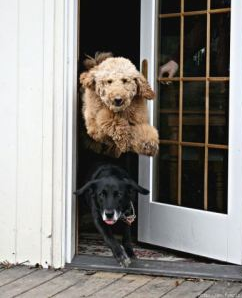 Does your dog dash out the door the second you open it? A big dog dashing through an open door can knock people over and injure them, especially if there are steps outside the door. If you have a large and small dog, the small dog can be trampled or bowled over by the larger dog. Any dog, large or small, can be injured or killed by dashing out of a car door into traffic, or dashing into a car before the door is fully open. Teaching your dog to sit and stay at every open door until you release them can save the life and limbs of you, your guests, and your dog.
Does your dog dash out the door the second you open it? A big dog dashing through an open door can knock people over and injure them, especially if there are steps outside the door. If you have a large and small dog, the small dog can be trampled or bowled over by the larger dog. Any dog, large or small, can be injured or killed by dashing out of a car door into traffic, or dashing into a car before the door is fully open. Teaching your dog to sit and stay at every open door until you release them can save the life and limbs of you, your guests, and your dog.
It’s an easy skill to teach but takes patience. You won’t need treats for this because going through the door is the reward for your dog. Start teaching your dog to stay at the door when your dog really wants to go out the door, such as for a walk or car ride (but not when your dog has an urgent need pee or poop!). Put your hand on the doorknob and ask your dog to sit. As soon as your dog sits, say “Stay” in a deep, low, slow voice, hold out your hand in the classic policeman Stop signal, and maintain eye contact with your dog. Turn the doorknob and start to open the door. If your dog’s butt leaves the floor, immediately shut the door.
Keep repeating until you can open the door a few inches without your dog’s butt leaving the floor. Each time you go in or out of a door, ask your dog to sit until the door opens a little bit more. Your dog will quickly learn that her butt controls the door. Eventually you can work up to your dog sitting and waiting to be released with the door completely open.
Once your dog has mastered “stay at the door” in your home, teach her to stay before entering or leaving your car. Extend “stay at the door” to every door your dog goes through, at home, at your friend’s house, the vet, Pet Smart, and the fence to the dog park. Using this same technique, you can also extend this skill to a polite sit and stay as company enters the house.
The more you extend this skill, the more amazed your dog will be at the power of her sitting butt!
Send your dog training and behavior questions to [email protected].
Or put them in the comments section.



Write a Letter to the Editor on this Article
We encourage readers to offer their point of view on this article by submitting the following form. Editing is sometimes necessary and is done at the discretion of the editorial staff.